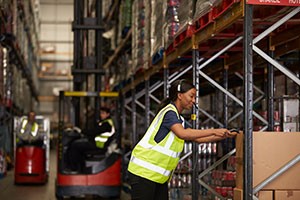Stay Safe Around Warehouse Racking

Racking optimizes the space inside a warehouse. It’s useful, efficient, and provides a great business storage solution. If set up poorly, it can cause problems for both employers and employees. When the racking is too low or too high, it puts a strain on the worker’s body that can lead to injuries and workers’ compensation costs.
When pallets are placed on the floor in a bin, workers typically have to bend down to reach the product. The constant stress of bending and picking items up will start to affect their performance and health. Fortunately, there is more than one way for employees to access lower product.
- Use a level loader whenever possible. The loader will rise when items are taken off, making the product much more accessible.
- Stack a loaded pallet on top of other empty pallets to raise the items above waist-height, making them easier to unload.
- Raise the bottom level of the racking so loads don’t require you to bend over.
- Use a pallet jack to pull the product out from under the racking to make picking the product much more convenient.
For products that are higher up, employees must reach above their heads—putting unnecessary strain on the shoulders, back, hands, and wrists. To work more ergonomically:
- Only use overhead racking for excess product. Prior to selecting the product, lower it down using a forklift or reach truck.
- Employers should supply their workers with “pick sticks” or “bo peep hooks” to pull smaller products closer to them before taking the product off the shelf.
To avoid strain when reaching for both high or low product, rotate the pallets when items start disappearing from the front. Moving the product from the back to the front will make it much easier for workers to reach items without risk.
Warehouse racking and product location are vital to anybody who works in a distribution environment daily. Knowing how to maneuver product and pallets will keep everyone safe and healthy.



